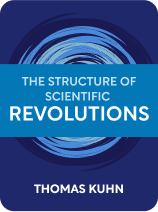

This article is an excerpt from the Shortform book guide to "The Structure Of Scientific Revolutions" by Thomas Kuhn. Shortform has the world's best summaries and analyses of books you should be reading.
Like this article? Sign up for a free trial here .
What is normal science? How do the methods of normal science differ from those of revolutionary science?
Normal science means study based on previous scientific knowledge. In contrast to revolutionary science, normal science doesn’t try to find new information, but only to confirm and refine current beliefs.
Read more to learn about normal science and its methods.
What Is Normal Science?
Normal science means study based on previous scientific knowledge. That knowledge is usually learned through textbooks and formal education, which outline the main questions of a field and the methods used to answer them. Before textbooks became common, the old classics like Aristotle’s Physica had much the same purpose.
These books became influential for two reasons: first, because they were remarkable enough to attract a loyal following at a time when many schools of thought were competing with each other; second, because they left a lot of questions and unsolved problems—puzzles for their followers to solve.
Scientific discoveries that have those two characteristics become paradigms: They are perfect examples of their fields, and a lot of information can be extrapolated from them. Paradigms are at the heart of normal science. They are the models that future experiments and theories are based on. This is why we use phrases like Newtonian physics: physics based on the paradigm of Newton’s discoveries.
Students prepare for their work in chosen scientific communities by studying paradigms. Physicists, for example, would study Newton’s work and how to apply his principles to modern science.
Because of this, scientists in the same community will follow the same rules and models in their work. This helps lead to scientific consensus, which is needed for normal science to progress.
Scientific Paradigms
A scientific paradigm is something to be further studied and refined under new or stricter conditions. Paradigms tend to be very limited and imprecise when they’re first established, so normal science is all about expanding the paradigm and filling the gaps in it.
Normal science doesn’t try to find new theories or explanations for things. In fact, new information that doesn’t fit the paradigm is usually ignored or brushed aside completely. However, that’s not to say that normal science should be disparaged. While the paradigm hugely reduces the scope of normal science, it allows the depth of study that’s key to advancing science. In fact, most scientists practice normal science for their entire careers.
Normal science has three common areas of interest. The first is taking what we already know and improving the specificity, accuracy, or breadth of that knowledge. Scientists will try to make observations that line up with the example set by the paradigm, thereby making the paradigm stronger and more convincing.
One example was Foucault demonstrating that the speed of light is slightly reduced by water; his experiment strengthened the then-current wave theory of light, since the previous particle theory said that water would “pull” on the light particles and make them move faster.
The second area of interest is finding problems in the paradigm and solving them. For example, Newton proposed the existence of gravity, but it wasn’t until a century later that scientists were able to measure a universal gravitational constant. Science’s inability to come up with that constant was seen as a major problem with the paradigm, and it may have led to a crisis if it had remained unsolved.
The third area of interest is closely related to the second. It involves applying a paradigm to phenomena other than the ones it was originally based on, proving that it works under more circumstances. Broadening the paradigm is another method of strengthening it.
However, normal science is not purely experimental; it has theoretical aspects too. Theoretical science’s areas of interest are similar to experimental science.
First, theoretical science uses existing theories to predict new facts, preferably ones that can then be confirmed by experiments. Second, it connects theories to observations about the world, thereby making the theory stronger. Third, it finds problems in the accepted theory and solves them—sometimes this happens simply by rewording or clarifying the theory, rather than actually adjusting it.
Solving Puzzles Through Science
One of the most notable things about normal science is that it doesn’t try to find new information, but only to confirm and refine current beliefs. Results that don’t fit into the paradigm are often set aside, and sometimes don’t make sense until much later.
For example, early experiments that showed the attractive power of electricity didn’t give consistent or easily explained results, so they were set aside as unexplained phenomena. It wasn’t until the paradigm shifted away from the liquid model of electricity that they started making sense.
Given this fact, it might seem strange that so many people are so interested in normal science. However, normal science is still challenging—it’s often about how to get the expected results, rather than the results themselves. It’s like solving a jigsaw puzzle: Even though you already know what the outcome is supposed to be (the picture on the box), the challenge and the enjoyment come from figuring out how to achieve it.
A scientist can prove his or her skill and creativity by solving a difficult scientific puzzle. This can also involve developing all sorts of new procedures and equipment, which are worthy challenges for any scientist.
A key aspect of puzzles is that they must have solutions. Therefore, scientific fields will tend to look for problems that—if their paradigms hold true—are solvable. Problems outside of that scope will often be dismissed as belonging to a different field of science, or as just too obscure or troublesome to bother with.
Also, both puzzles and scientific problems must have rules by which those solutions can be found. For example, in the eighteenth century, scientists consistently failed to apply Newton’s laws of motion to the movement of the moon. Some scientists suggested replacing one of his mathematical laws with a different one that would work for the problem—however, that would have been changing the paradigm, and thus breaking the rules. Finally, in 1750, a scientist found the solution using Newton’s laws as they were written, and so the paradigm remained in effect.
Scientific “rules” fall into 4 major categories. The first is scientific laws and theories, such as Newton’s Laws of Motion. The second is which scientific instruments may be used to study the paradigm, and how.
The third category is broad, high-level concepts. For example, in the mid 17th century, scientists believed that the entire universe—including all natural forces—was made of particles. They believed that every natural phenomenon could be explained by particle size and shape, how they moved, and how they interacted with each other. Therefore, the “rules” of that time would force them to explain any findings in those terms, such as describing light as tiny, solid bodies that travel in a straight line and have some minuscule amount of momentum.
The fourth category is personal rules for scientists. Unlike the previous categories, this tends to be the same across all fields of study. In short, scientists must be committed to examining and understanding the world, with special focus on some particular part of it. If their studies reveal anomalies, either the methods or the theories must be refined.
However, scientists in a given field have more in common than just rules they follow, which is why we place so much emphasis on the paradigms they use. Rules come from paradigms, but paradigms can be used as guides even without established rules (this is explored in the next chapter).

———End of Preview———
Like what you just read? Read the rest of the world's best book summary and analysis of Thomas Kuhn's "The Structure Of Scientific Revolutions" at Shortform .
Here's what you'll find in our full The Structure Of Scientific Revolutions summary :
- How scientific paradigms evolve and become replaced with new paradigms
- Why science is more about figuring out what isn't right
- How throwing out past achievements allows for scientific progress






